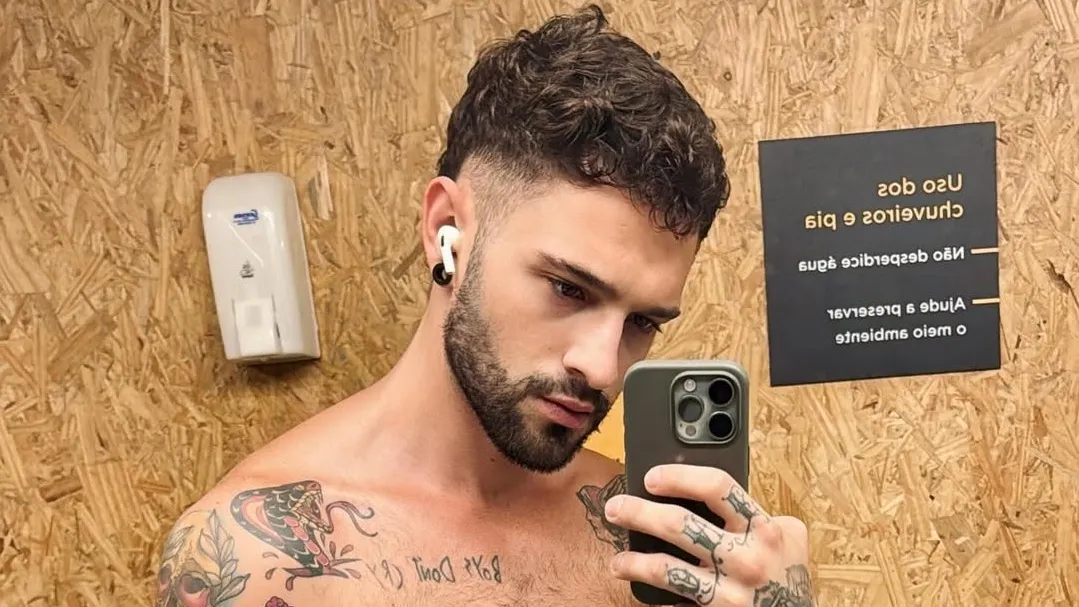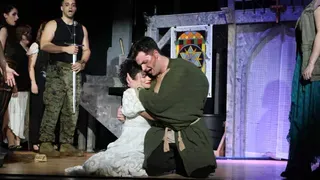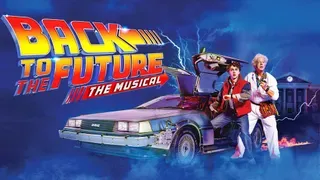December 20, 2013
The Heart of Robin Hood
Kilian Melloy READ TIME: 5 MIN.
Playwright and Royal Shakespeare Company Associate Director David Farr had two worthy and fascinating tasks in mind when writing "The Heart of Robin Hood." The first -- marching orders handed down (or, I guess, up) from his daughters -- was to write a strong, capable female character. The second was to peel back the heroic gloss that has come to obscure the original conception of Robin Hood and re-visit the character as he first appeared: A figure of danger and violence, sort of a forest-dwelling bogeyman.
Done, and done. In the American Repertory Theatre's production of the play (which has been a sensation in England), we meet a Marion (Christina Bennett Lind) who isn't so much "maid" as "made for trouble," and a Robin Hood (Jordan Dean) whose last thought is to steal from the rich and give to the poor. He'll steal from rich and poor alike and do it for personal gain, not to mention the sheer pleasure of following his own impulses.
Re-write the two figures at the crux of the myth, and the rest of the characters fall into place almost on their own. The "merry men" are a band, not of pranksters, but of killers and thugs; a corrupt monk named Friar Tuck falls in with them just long enough to catch a thrown knife in the eye and drop dead. (Robin Hood is the knife-thrower. So much for that happy little tale of larky brotherhood.)
These thieves may not necessarily have a code of honor, but they do have an ethos, which is this: Men should be free to roam in the woods and pretty much do as the spirit moves them. And they should have inner peace while they're doing it -- which precludes the presence of women, who perturb and upset men, making them "irrational" and "unreliable." (After all, if there's one job description in which "rational" and "reliable" feature prominently, it's Woodlands Highwayman.)
But when Robin meets Marion... well, the equation is obvious. He's smitten, despite his avowed refusal to have anything to do with the female sex. She's equally captivated, partly because she already admires Robin Hood's anarchic life -- and then, too, there's the matter of her being pressed to marry a suitor, Prince John (Damian Young), a sadistic schemer looking to take over the kingdom under the guise of fighting the Crusades. So nasty is Prince John that he murders peasants who refuse to pay up for his "holy contribution" and then smears them as heretics and traitors, if not the spawn of the Devil himself. (With a few emendations this role, too, could have boasted a strong female presence -- had Sarah Palin or Michele Bachmann only lived in the 12th century.)
Such dirty business results in two orphans, Sarah and her older brother Jethro (Claire Candela and Andrew Cekala, respectively) taking refuge with Robin Hood, whose band of men have found their consciences thanks to a young hellion named Martin... the male alter-ego of Marion, dressed for the role thanks to the fashion sense of her flamboyant retainer Pierre (Christopher Sieber), a refined gay man in a time well before gay was chic. Not that there aren't a few gay undercurrents between Robin and Martin... ah, but then again, what we know (and Robin doesn't) is that the woman who haunts and fosters tempests in his heart is also the man he started out meaning to kill before making common cause with him. This is one loaded bromance.
If all this isn't gleefully anarchic and anachronistic enough, consider the live music, played with bluegrass brio by the band Poor Old Shine. This is a five-member group from Connecticut that dresses like something from the years just after the American Civil War and plays instruments that include guitar, modern drum kits, and something that looks like a hybrid string instrument kit-bashed from a banjo and a mandolin. Poor Old Shine is credited for the music and, along with Farr, with the lyrics for the play's songs; no Middle English lays, these, but rather ditties and reels that feel like they originated in the rills and wrinkles of Kentucky before settling into Sherwood Forest, where, strangely enough, they fit right in. Then again, maybe it's not so strange; nothing captures the mood of a people like their songs, and nothing is so American as bluegrass. The yearning for space in which to move, invent, and explore is already abroad in the England of this play; it's just going to have to wait, oh, say, half a millennium (and travel to a new continent) to reach its fullest flowering.
The production's energy is every bit as electric as the characterizations, which helps gloss over the ramshackle plotting. (Airtight logic is hardly the point here, so don't come looking for it; expect instead zip, verve, and heroic fantasy.) Icelandic director G�sli �rn Gar�arsson (a previous collaborator with Farr) oversees a cast whose talents include acrobatic leaps and bounds, not to mention sharp comic timing: Moe Alafrangy (and a Goth-looking henchman) and Zachary Eisenstat (as Will, one of Robin Hood's men) display their airborne chops, while Jeremy Crawford takes on the role of Little John; Katrina Yaukey plays Marion's bad seed of a sister Alice (among a plethora of other roles); Laura Sheehy plays a trio of human roles as well as miming a dog named Plug (vividly evoking his canine yelps and barks with an oboe); and Louis Tucci keeps busy with more than half a dozen parts (including the luckless Friar Tuck). The performance I saw also included Daniel Berger-Jones, who was subbing in for Andy Grotelueschen in the role of Much Miller.
B�rkur J�nsson's scenic design echoes and intensifies the larger-than-life, mythic sensibility that informs the script and direction. A huge tree towers over the set, its branches stretching above the audience, while the green of a steep slope (representing the endless green vista of a deep forest or the ivy-covered walls of a castle keep) gives the athletic cast another option for scrambling, sliding, and gravity-defiant quick-stepping. (There's also a fair amount of graceful rope work, including a hilarious "human puppet" scene.) The rest of the design team also follows this ethic, from Bj�rn Helgarson's lighting to the leather and heavy fabrics of Emma Ryott's costumes, to Joe Bostick's hurley-burley fight direction, Jonathan Deans' sound design, and Kris Kukul's music direction. Everything here seems vast enough to swallow you up -- and, for two hours, "The Heart of Robin Hood" does just that.
Kilian Melloy serves as EDGE Media Network's Associate Arts Editor and Staff Contributor. His professional memberships include the National Lesbian & Gay Journalists Association, the Boston Online Film Critics Association, The Gay and Lesbian Entertainment Critics Association, and the Boston Theater Critics Association's Elliot Norton Awards Committee.






